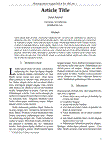Search Results - ((testooe OR testen) OR ((est OR (gesteao OR restos)) OR (testigos OR (estaos OR esteers)))) point*
Suggested Topics within your search.
Suggested Topics within your search.
- México 7
- Educación 4
- Education 4
- Mexico 4
- Democracia 3
- Democracy 3
- Estado 3
- Facebook 3
- State 3
- democracia 3
- Alimentación 2
- Alternative dispute resolution 2
- Calidad 2
- Conocimiento 2
- Derechos Humanos 2
- Elecciones 2
- Elections 2
- España 2
- Family Business 2
- Filosofía política 2
- Historia 2
- History 2
- Human Capital 2
- I31 2
- Innovación 2
- Innovation 2
- Knowledge 2
- O47 2
- Política 2
- Pymes 2
-
1
-
2
-
3
-
4
-
5
El arte como actividad práxica en el pensamiento de Severo Iglesias
Published 2023Get full text
Article -
6
-
7
PLANTAS NATIVAS USADAS COMO ALIMENTOS, CONDIMENTOS Y BEBIDAS DE LAS COMUNIDADES VEGETACIONALES DESERTICAS O SEMIDESERTICAS EN NUEVO LEON, MEXICO.
Published 2001“…Diverse authors have studied the regionalflora from the point of view of their use. Information of the native flora wassuccessfully obtained that they are consumed like foods, condimentos and drinks, partof the used plant and form of use, of 20 botanical families and 39 species consideringthe types of vegetation where the species of consumed flora are located. …”
Get full text
Article -
8
La degradación del Estado y del sujeto en la ideología neoliberal
Published 2024Get full text
Article -
9
El arte en la era digital: teorizaciones, desafíos y reflexiones
Published 2025Get full text
Article -
10
Análisis de expresión de genes de Mycobacterium tuberculosis durante la infección a macrófagos
Published 2006“…THP-1 cells monolayers differentiated to macrophages by phorbol myristate acetate (PMA) were infected with M. tuberculosis strains CDC1551, H37Rv and DR689 with a variable multiplicity of infection (MOI): 10:1, 1:1 and 0.1:1 (bacteria:macrophage) and incubated at various time points. Cytotoxicity was observed as areas of clearing and cell agglomeration and the effect was dependent on bacilli inoculum and incubation time. …”
Get full text
Tesis -
11
Análisis de expresión de genes de Mycobacterium tuberculosis durante la infección a macrófagos
Published 2006“…THP-1 cells monolayers differentiated to macrophages by phorbol myristate acetate (PMA) were infected with M. tuberculosis strains CDC1551, H37Rv and DR689 with a variable multiplicity of infection (MOI): 10:1, 1:1 and 0.1:1 (bacteria:macrophage) and incubated at various time points. Cytotoxicity was observed as areas of clearing and cell agglomeration and the effect was dependent on bacilli inoculum and incubation time. …”
Get full text
Tesis -
12
-
13
Quién es quién en el consumo mundial de acero: impactos y tendencias globales
Published 2012Get full text
Article -
14
Políticas públicas de integración de inmigrantes. Éxitos y fracasos en Venezuela
Published 2020Get full text
Article -
15
Who's who in the steel consumption in the world: global trends and impact (Quién es quién en el consumo mundial de acero: impactos y tendencias globales)
Published 2012“…It is important to determine the main differences and identify the key points of improvement; this may help improve the strategy for getting better numbers in order to improve and maintain constant growth of a country and ensure a sustainable development. …”
Get full text
Article -
16
Diferencias de género en las actitudes hacia las matemáticas = Gender differences in attitudes toward mathematics
Published 2018“…Abstract The results of previous research do not allow us to generalize the existence of gender differences in attitudes toward mathematics, however they coincide in the majority in pointing out that men have a greater extrinsic motivation, that they show greater confidence in their future achievements in the area of mathematics, less anxiety about mathematics and attribution of success to external causes. …”
Get full text
Article -
17
CALIDAD BACTERIOLOGICA DE ENSALADAS DE ZANAHORIA RALLADA Y EFICACIA DE TRATAMIENTOS PREVIOS A SU CONSUMO
Published 2017“…Discussion: It should be pointed out the importance of the microbiological quality of raw material, since the 35% of the samples do not reach the requirements even applying the treatment with hypochlorite. …”
Get full text
Article -
18
INTERVENCION NUTRICIONAL A PACIENTES CON ENFERMEDAD DE PARKINSON
Published 2017“…Dysphagia was the one with the highest nutritional response, 45 percentage points lower than the initial one, followed by constipation with 31.5 Percentage points, 74.3% of the patients maintained their CMB values at the end of the initial one, and the rest of them increased their values. …”
Get full text
Article -
19
-
20


